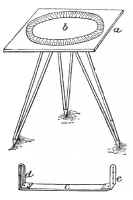|
 Article taken from "Backsights"
Magazine published by Surveyors Historical Society
Article taken from "Backsights"
Magazine published by Surveyors Historical Society
|
From
Spons’ Workshop Receipts For Manufacturers Mechanics And Scientific Amateurs,
Vol. III - Jointing Pipes to Pumps. London: E.& F.N. Spon, Ltd., Revised
Edition, 1909.
 A
simple means of measuring angles is shown in Fig. 40. The board a usually
of deal, which should be about 15 in. square, underneath it has screwed onto it
in the centre a brass boss, which fits into a similarly shaped recess in the
wooden head of a folding tripod stand. A brass clamping screw passes from below
through a hole in the centre of the tripod head, and screws into the brass boss
on the board. By this means the board, or plane table, as it is here termed, can
be smoothly turned round horizontally into any position and securely clamped
there. A
simple means of measuring angles is shown in Fig. 40. The board a usually
of deal, which should be about 15 in. square, underneath it has screwed onto it
in the centre a brass boss, which fits into a similarly shaped recess in the
wooden head of a folding tripod stand. A brass clamping screw passes from below
through a hole in the centre of the tripod head, and screws into the brass boss
on the board. By this means the board, or plane table, as it is here termed, can
be smoothly turned round horizontally into any position and securely clamped
there.
On the top of the board is pasted or
glued a cardboard protractor b. These protractors are about 12 in.
diameter, and are graduated to ¼ degree, and can be bought for a small sum.
Care should be taken to attach this flatly to the board.
The next essential is a sight-rule c.
This consists of a flat piece of some hard wood about 15" in. long by
2-1/4" in. wide, and 1/2" in. thick, having one edge bevelled. On each
end is fitted centrally a brass sight-vane - one d having a wide slot
through its upstanding part, down the centre of which is fitted a fine wire or
hair; the other e has a fine slit down its centre.
To measure an angle between two
objects, the plane table is set up as level as possible by eye, the sight rule
is placed across its centre of the protractor, and pointed in the direction of
the left-hand object, the eye being applied to the slit in e, and the
wire in d being brought into coincidence with the object. Care must be
taken that the bevelled edge of the rule lies nearly over the centre of the
protractor. This is easily ensured by placing the finger or the uncut end of as
pencil touching the centre point, and using this as a pivot round which to turn
the rule. The graduations of the protractor cut by the beveled edge of the rule
are then read at each end, and their mean is taken as the true direction of the
object. A similar observation is then taken to the right-hand object, care being
always taken to use the mean of the readings at each end of the rule. The
difference between the readings to the two objects give the angle required.
A most surprising degree of accuracy
can be obtained by the use of this simple instrument by repeating the
observations on a different part of the graduation. It is, in fact, a very fair
theodolite without a telescope.
If a magnetic compass is used in
conjunction with the plane table, and by its means the table and protractor be
turned round and set magnetic north and south, accurate magnetic bearings of
objects can be obtained with equal facility.
|
